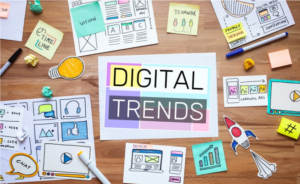In today’s highly competitive marketplace, keeping up with the latest B2B digital marketing trends has become essential for businesses looking to stay ahead of the curve. As technology advances, new digital marketing trends emerge, transforming how companies connect with their audience, drive sales, and build brand awareness.
We’re halfway through 2024 and we’ve seen great promise for B2B digital marketing, with innovative strategies and tactics revolutionizing the industry. To help your business stay on top of the game, we have compiled a comprehensive guide of key B2B digital marketing trends you can adopt to carry out 2024.
By embracing these trends, you can effectively engage your target audience and watch your marketing efforts transform your business and achieve success. So, without further ado, let’s dive in and explore what B2B digital marketing trends have dominated the landscape in 2024!
. . .
Contents
- Trend 1: Advanced Personalization
- Trend 2: Account-Based Marketing (ABM) Evolution
- Trend 3: Content Marketing and Thought Leadership
- Trend 4: Video Marketing and Webinars
- Trend 5: Data-Driven Marketing Strategies
- Trend 6: Enhanced SEO and SEM Practices
- Trend 7: Integration of Social Media Platforms
- Trend 8: Leveraging Marketing Automation
- Conclusion
. . .
Trend 1: Advanced Personalization

Explanation of Advanced Personalization in B2B Marketing
Advanced personalization is one of the most impactful B2B digital marketing trends. It involves tailoring marketing efforts to individual business clients’ needs, preferences, and behaviors. Unlike generic marketing strategies, advanced personalization uses detailed data and insights to create highly relevant and targeted content that resonates with the niche audience.
Using AI and Machine Learning for Personalized Content and Experiences
AI and machine learning are revolutionizing B2B digital marketing trends by enabling advanced personalization at scale. These technologies analyze vast amounts of data to predict customer behavior, preferences, and potential needs, allowing marketers to deliver personalized content and experiences.
For instance, AI-driven recommendation engines can suggest relevant products or services based on a client’s previous interactions, enhancing the overall customer experience.
Examples of Successful Advanced Personalization Strategies
Successful personalization strategies include customized email campaigns, personalized landing pages, and targeted content marketing. For example, a company might use AI to segment its audience and send tailored email content that addresses specific pain points or interests.
Another example is creating dynamic website content that changes based on the visitor’s industry, job role, or previous interactions with the site. By adopting these advanced personalization tactics, businesses can stay ahead in the competitive landscape of B2B digital marketing trends.
Trend 2: Account-Based Marketing (ABM) Evolution

Importance of ABM as a B2B Digital Marketing Trend
Account-Based Marketing (ABM) is a highly focused business strategy where marketing and sales teams collaborate to target and nurture high-value accounts. Unlike broad marketing approaches, ABM concentrates on specific accounts, tailoring marketing efforts to meet the unique needs and preferences of each target.
Additionally, it allows businesses to build deeper relationships with key clients, increasing the chances of conversion and long-term engagement. ABM is particularly effective in B2B settings where the sales cycle is longer and decision-making involves multiple stakeholders.
Latest Advancements and Tools in ABM
The evolution of ABM as a B2B digital marketing trend has been propelled by various advancements and tools. Modern ABM strategies leverage data analytics and AI to gain deeper insights into target accounts, enabling more precise targeting and personalization. Tools like intent data platforms help identify potential clients who are showing buying intent, while predictive analytics can forecast account behavior and needs.
Additionally, ABM platforms such as HubSpot, Demandbase, and Terminus offer integrated solutions that streamline the ABM process, from account identification to engagement and measurement. These tools enhance the ability to deliver personalized experiences at scale, making ABM more effective and efficient.
How to Implement and Optimize ABM Strategies
Implementing and optimizing ABM strategies involves several key steps:
- Firstly, identify and select high-value accounts that align with your business goals. This selection should be based on detailed criteria such as industry, company size, and potential revenue.
- Next, gather comprehensive data on these accounts to understand their needs, challenges, and decision-making processes.
- Develop personalized marketing campaigns tailored to each account, utilizing content and messaging that resonate with their specific pain points and objectives. Collaboration between marketing and sales teams is vital to ensure a cohesive approach.
- Lastly, regularly review and adjust your ABM strategies based on performance metrics and feedback. Use analytics tools to track engagement and conversion rates, and refine your tactics to enhance effectiveness.
By continuously optimizing your ABM efforts, you can maximize the impact of your B2B digital marketing trends, ensuring sustained growth and success.
Trend 3: Content Marketing and Thought Leadership

Role of Content Marketing in Building Brand Authority
Content marketing, one of the most popular B2B digital marketing trends, helps businesses build brand authority and credibility. By consistently producing valuable and relevant content, companies can position themselves as experts in their industry.
This not only attracts potential clients but also fosters trust and loyalty among existing customers. Effective content marketing showcases a business’s expertise, solves problems for its audience, and demonstrates a deep understanding of industry challenges.
Emphasis on Creating High-Quality, Informative Content
A significant part of content marketing is creating high-quality, informative content. This includes blog posts, whitepapers, eBooks, case studies, and webinars that provide actionable insights and valuable information to the target audience.
High-quality content should be well-researched, engaging, and tailored to address the audience’s specific needs and pain points. By focusing on quality over quantity, businesses can ensure their content stands out and effectively communicates their value proposition.
Strategies for Establishing Thought Leadership in the Industry
Utilizing content marketing to establish thought leadership is a key component of B2B digital marketing. To achieve this, B2B businesses should employ several strategies:
- Consistent Content Production: Regularly publishing insightful and authoritative content helps maintain visibility and relevance in the industry. This can include blogs, articles, and industry reports that address current trends and issues.
- Guest Blogging and Speaking Engagements: Contributing to reputable industry publications and participating in speaking engagements at conferences and webinars can enhance a company’s thought leadership status.
- Engaging on Social Media: Actively participating in industry discussions on social media platforms like LinkedIn can help businesses share their expertise and connect with other thought leaders.
- Collaborating with Industry Influencers: Partnering with well-respected industry influencers can amplify a company’s reach and credibility. Influencers can help validate and promote the company’s insights and perspectives.
- Educational Content: Offering educational resources such as online courses, workshops, and how-to guides can further establish a company as a thought leader. Providing in-depth knowledge and training helps build trust and positions the company as a valuable resource.
By implementing these strategies, businesses can effectively leverage content marketing to establish and maintain thought leadership, keeping them at the forefront of B2B digital marketing trends.
Trend 4: Video Marketing and Webinars

Growing Significance of Video Content in B2B Marketing
Video content has become an increasingly important B2B digital marketing trend. It offers a dynamic and engaging way to convey complex information, showcase products, and tell a brand’s story. Videos are highly shareable, which can significantly boost brand visibility and engagement.
In an age where visual content is preferred, incorporating video into B2B marketing strategies can help businesses capture and retain the attention of their target audience, making them a crucial tool in the marketing arsenal.
Tips for Creating Engaging and Impactful Video Content
To capitalize on the growing importance of video content in B2B digital marketing trends, businesses should focus on creating engaging and impactful videos. Here are some tips:
- Know Your Audience: Understand the specific needs and preferences of your target audience. Tailor your video content to address their pain points and provide solutions relevant to their industry.
- Keep It Concise: Attention spans are short, so keep your videos concise and to the point. Aim for clarity and brevity while ensuring the message is effectively communicated.
- Tell a Story: Use storytelling techniques to make your videos more relatable and memorable. A compelling narrative can help illustrate your value proposition and engage viewers on an emotional level.
- High Production Quality: Invest in good production quality to ensure your videos are professional and polished. This includes clear audio, sharp visuals, and smooth editing.
- Include a Call to Action: End your videos with a clear call to action, encouraging viewers to take the next step, whether it’s visiting your website, signing up for a webinar, or downloading a resource.
- Promote Across Channels: Maximize the reach of your video content by promoting it across various channels, including your website, social media, email campaigns, and industry forums.
By following these tips, businesses can create video content that not only aligns with current B2B digital marketing trends but also effectively engages and converts their target audience.
Benefits of Using Webinars for Lead Generation and Education
Webinars have also emerged as a powerful B2B digital marketing trend, providing substantial benefits for lead generation and customer education. They offer a platform for businesses to demonstrate their expertise, share valuable insights, and engage directly with their audience.
Additionally, webinars can attract high-quality leads by addressing specific industry challenges and offering practical solutions. They provide an interactive format that encourages real-time engagement and feedback, helping to build stronger relationships with potential clients.
Trend 5: Data-Driven Marketing Strategies

Importance of Data Analytics in B2B Marketing
Data-driven marketing strategies have also become essential for achieving success. Data analytics allows businesses to gain deep insights into customer behavior, preferences, and purchasing patterns.
By analyzing this data, companies can make informed decisions, personalize their marketing efforts, and optimize their campaigns for better results. The ability to leverage data effectively can lead to more precise targeting, improved customer engagement, and higher ROI, making it a cornerstone of modern B2B marketing strategies.
Tools and Techniques for Leveraging Data to Inform Marketing Decisions
To harness the power of data-driven marketing, businesses can utilize a variety of tools and techniques. Several key tools and techniques include:
- Customer Relationship Management (CRM) Systems: Platforms like Salesforce, HubSpot, and Zoho CRM manage customer data, track interactions, and analyze sales performance.
- Analytics Tools: Google Analytics, Adobe Analytics, and Kissmetrics for tracking website traffic, user behavior, and conversion rates. Tools like Tableau and Microsoft Power BI for data visualization and in-depth analytics.
- Marketing Automation Platforms: Tools like Marketo, Pardot, and ActiveCampaign to automate and analyze marketing campaigns, segment audiences, and measure engagement.
- Social Media Analytics: Hootsuite, Sprout Social, and Buffer for analyzing social media performance, tracking engagement, and understanding audience demographics.
- A/B Testing and Optimization Tools: Optimizely and VWO for conducting A/B tests, multivariate tests, and optimizing website and email content based on performance data.
- Customer Feedback and Survey Tools: SurveyMonkey, Qualtrics, and Typeform for collecting and analyzing customer feedback to inform marketing strategies.
- Email Marketing Analytics: Mailchimp, Constant Contact, and SendinBlue for tracking email open rates, click-through rates, and conversions.
- Predictive Analytics and Machine Learning: IBM Watson, SAS Analytics, and RapidMiner for predictive modeling, identifying trends, and making data-driven marketing forecasts.
- SEO and SEM Tools: SEMrush, Ahrefs, and Moz for keyword research, tracking search rankings, and analyzing competitors.
- Data Management Platforms (DMPs): Oracle DMP and Adobe Audience Manager for collecting, organizing, and analyzing large datasets to improve targeting and personalization.
By integrating these tools and techniques into their marketing processes, businesses can stay ahead of B2B digital marketing trends and make strategic decisions that drive success and enhance overall campaign performance.
Examples of Data-Driven Campaigns
There are several ways to illustrate the effectiveness of data-driven marketing strategies in your campaigns. For instance, a software company might use predictive analytics to identify potential leads based on their behavior and interactions with the company’s content. By tailoring personalized email campaigns to these leads, the company can significantly increase conversion rates.
Another example is a manufacturing firm that utilizes data from its CRM system to segment its audience and deliver targeted content through marketing automation. This ensures that each segment receives relevant information, enhancing engagement and driving sales.
These examples demonstrate how leveraging data can lead to more effective and impactful marketing campaigns, solidifying the role of data-driven strategies in the future of B2B digital marketing trends.
Trend 6: Enhanced SEO and SEM Practices

Importance of SEO and SEM for B2B Businesses
Search engine optimization (SEO) and search engine marketing (SEM) are crucial for enhancing online visibility and attracting qualified leads. SEO focuses on optimizing a website to rank higher in organic search results, while SEM involves using paid search ads to reach potential customers.
Together, these practices help B2B businesses increase their online presence, drive targeted traffic, and ultimately boost conversions. In an increasingly competitive digital marketplace, effective SEO and SEM strategies are essential for standing out and capturing the attention of decision-makers.
Latest Trends and Updates in SEO and SEM
Staying current with the latest SEO and SEM trends is vital for maintaining a competitive edge in B2B digital marketing trends. Several recent updates include:
- Core Web Vitals and Page Experience:
- Google’s Core Web Vitals, including metrics like Largest Contentful Paint (LCP), First Input Delay (FID), and Cumulative Layout Shift (CLS), are crucial for ranking.
- Emphasis on overall user experience, including mobile-friendliness, secure browsing (HTTPS), and no intrusive interstitials.
- AI and Machine Learning:
- Increased use of AI-driven tools like Google’s RankBrain and BERT to better understand search queries and deliver more relevant results.
- Adoption of AI tools for content optimization and keyword research, such as Clearscope and SurferSEO.
- Voice Search Optimization:
- Growing importance of optimizing content for voice search queries, which tend to be longer and more conversational.
- Incorporation of question-based keywords and natural language processing to align with how people speak.
- Local SEO and Google Business Profile:
- Enhanced features in Google Business Profile, such as posts, Q&A, and updates, to improve local search visibility.
- Importance of local citations, reviews, and consistent NAP (Name, Address, Phone number) information.
- YouTube SEO:
- Optimization of video content on YouTube, including relevant keywords in titles, descriptions, and tags, and also incorporating closed captions and transcripts to improve accessibility and SEO.
- Creation of engaging thumbnails and playlists to enhance viewer retention and discoverability.
- Featured Snippets and Zero-Click Searches:
- Targeting content to appear in featured snippets, knowledge panels, and other rich results to capture zero-click searches.
- Structuring content with clear headings, lists, and concise answers to common questions.
- User Intent and Semantic Search:
- Focus on understanding and matching user intent behind search queries, moving beyond keyword matching to content relevance.
- Use of semantic search principles to provide comprehensive and contextually relevant content.
- Automated and Smart Bidding in SEM:
- Adoption of automated bidding strategies in Google Ads and other platforms to optimize bids based on real-time data.
- Use of smart bidding techniques like Target CPA, Target ROAS, and Enhanced CPC to improve campaign performance.
Keeping up with these SEO and SEM trends (among others) allows B2B businesses to stay competitive by improving search visibility, driving more traffic, and achieving better marketing outcomes.
Best Practices for Improving Search Visibility and Driving Traffic
- First, conducting thorough keyword research is essential to identify the terms and phrases that potential customers are searching for. Creating high-quality, relevant content that addresses these keywords can help improve organic rankings.
- Additionally, optimizing on-page elements such as title tags, meta descriptions, and header tags can further boost search engine performance.
- Lastly, for SEM, leveraging data-driven insights to refine ad targeting and utilizing A/B testing to optimize ad copy and landing pages are effective strategies.
By following these best practices, B2B businesses can enhance their SEO and SEM efforts, driving more traffic and achieving better results in their digital marketing campaigns.
Trend 7: Integration of Social Media Platforms

Role of Social Media in B2B Marketing
Another popular B2B digital marketing trend that has taken over the digital world is the ever-growing usage of social media marketing. Social media platforms provide businesses with unique opportunities to build brand awareness, engage with their audience, and generate leads.
By sharing valuable content, participating in industry conversations, and showcasing thought leadership, B2B companies can strengthen their online presence and foster relationships with potential clients. Additionally, social media allows for targeted advertising and analytics, enabling businesses to refine their strategies and achieve better results.
Emerging Social Media Platforms and Their Potential
Keeping up with emerging social media platforms is crucial for staying ahead in B2B digital marketing trends. These social media platforms include:
- TikTok:
- Provides rapid growth and high engagement and has the potential for creating short, viral video content to increase brand visibility.
- Opportunities for B2B businesses to showcase behind-the-scenes content, product demos, and thought leadership in a creative format.
- Clubhouse:
- An audio-based social networking platform ideal for hosting live discussions, industry talks, and networking events.
- Potential for building authority and connecting with industry leaders through audio content.
- LinkedIn Live:
- A live video streaming feature on LinkedIn, which is great for real-time interaction with a professional audience.
- Useful for webinars, product launches, and Q&A sessions to engage B2B clients and prospects.
- Instagram Reels:
- A short-form video feature on Instagram that’s effective for sharing quick tips, industry insights, and promotional content.
- Potential to reach a younger, tech-savvy B2B audience through engaging visual content.
- X (Twitter) Spaces:
- Allows for live audio conversations on X (Twitter), which is suitable for hosting discussions, panel talks, and live Q&A sessions.
- Helps in engaging with followers in real time and building a community around your brand.
- Pinterest:
- A visual discovery and bookmarking platform that provides opportunities for B2B businesses in design, architecture, fashion, and other visual industries to showcase portfolios and case studies.
- Potential to drive traffic to your website through visually appealing pins.
- Reddit:
- A community-driven platform with topic-specific subreddits ideal for participating in industry-specific discussions and sharing valuable content.
- Potential to build authority and generate leads by engaging with niche communities.
- Discord:
- A voice, video, and text communication platform useful for creating private communities around your brand or industry.
- Potential for hosting webinars, live support, and interactive sessions with clients and prospects.
These platforms offer unique ways to reach and engage with a professional audience through live audio discussions, short-form videos, and other interactive content. Exploring and leveraging these emerging platforms can provide B2B businesses with fresh avenues for marketing and engagement.
Strategies for Effective Social Media Engagement and Lead Generation
To maximize the potential of social media within B2B digital marketing trends, businesses should implement effective strategies for engagement and lead generation. This includes:
- Creating and sharing high-quality content that resonates with their target audience, such as industry insights, case studies, and thought leadership pieces.
- Active participation in industry groups and discussions can also help establish credibility and connect with potential clients.
- Utilizing targeted ads and sponsored posts on platforms like LinkedIn and Facebook can further enhance lead-generation efforts.
- Leveraging analytics tools to track performance and refine strategies is essential for continuous improvement.
By adopting these strategies, B2B businesses can effectively integrate social media into their digital marketing efforts, driving engagement and generating valuable leads.
Trend 8: Leveraging Marketing Automation

Benefits of Marketing Automation for B2B Businesses
Among the top B2B digital marketing trends, marketing automation stands out for its ability to streamline processes and enhance efficiency. By automating repetitive tasks such as email marketing campaigns, lead nurturing, and social media posting, businesses can save time and resources while maintaining consistent communication with their audience.
Marketing automation also enables personalized interactions at scale, improving customer engagement and satisfaction. Furthermore, it provides valuable insights and analytics, helping businesses refine their strategies and make data-driven decisions.
Key Automation Tools and Their Functionalities
To capitalize on the advantages of marketing automation within B2B digital marketing trends, businesses should be familiar with these key automation tools and their functionalities:
- HubSpot:
- Comprehensive marketing automation platform with features, such as email marketing, lead scoring, CRM integration, and analytics.
- This platform automates workflows to nurture leads and track customer interactions.
- Marketo:
- Robust automation software by Adobe which provides tools for lead management, email marketing, and analytics.
- Specializes in account-based marketing (ABM) and multi-channel campaigns.
- Pardot:
- Salesforce’s B2B marketing automation solution focuses on lead generation, email marketing, and ROI reporting.
- Seamlessly integrates with Salesforce CRM for enhanced data management.
- Mailchimp:
- User-friendly email marketing and automation tool that offers features like email templates, segmentation, and A/B testing.
- Includes automation workflows for personalized email campaigns.
- ActiveCampaign:
- Integrated email marketing, automation, and CRM platform that provides advanced segmentation, lead scoring, and automation workflows.
- Enhances customer experience through targeted messaging.
- Eloqua:
- Oracle’s marketing automation solution includes features for campaign management, lead nurturing, and cross-channel orchestration.
- Delivers advanced analytics and ROI measurement.
- SharpSpring:
- All-in-one revenue growth platform, which offers email marketing, CRM, and automation capabilities.
- Provides behavior-based tracking and dynamic content for personalized experiences.
- Autopilot:
- Visual marketing automation software, featuring multi-channel messaging, lead nurturing, and customer journey mapping.
- Integrates with popular tools like Salesforce, HubSpot, and Slack.
- Drip:
- E-commerce-focused marketing automation platform, specializing in personalized email campaigns and behavior tracking.
- Provides detailed customer insights and analytics to boost engagement.
- Infusionsoft (Keap):
- CRM and marketing automation for small businesses, offering tools for email marketing, lead capture, and follow-up automation.
- Streamlines sales and marketing processes with comprehensive automation workflows.
These automation tools empower B2B marketers to streamline operations, nurture leads effectively, and optimize campaign performance, driving growth and maximizing ROI in the dynamic landscape of digital marketing.
How to Implement and Optimize Marketing Automation Workflows
Implementing and optimizing marketing automation workflows is essential for leveraging B2B digital marketing trends effectively.
- Begin by defining clear goals and identifying the tasks that can be automated, such as email follow-ups, lead nurturing sequences, and social media scheduling.
- Next, segment your audience based on criteria such as industry, company size, and behavior to ensure personalized communication.
- Develop targeted content and create automated workflows that guide leads through the customer journey.
- Regularly monitor performance metrics and use the insights gained to refine and optimize your workflows
By continuously iterating and improving your automation strategies, you can achieve higher efficiency, better engagement, and ultimately, increased ROI.
. . .
Conclusion
The B2B digital marketing trends landscape is set to evolve significantly in 2024 with a focus on advanced personalization, the evolution of account-based marketing (ABM), content marketing, video strategies, data-driven insights, SEO/SEM enhancements, social media integration, and marketing automation.
Staying informed about these trends is crucial for businesses aiming to remain competitive in an increasingly digital world. By implementing these strategies, businesses can enhance customer engagement, optimize marketing efforts, and ultimately achieve sustained growth and success in 2024 and beyond. Embrace these trends today to position your business at the forefront of B2B digital marketing innovation.
. . .
Ready to explore various B2B digital marketing trends for your business? Contact Synthesis Insights today to learn how we can help you implement these trends into your marketing strategy today!




